The Vatican is one of those must-see places whether you\'re a Roman Catholic or not and simply cannot be missed when visiting Rome but, it can be a little complicated to get your head around... Here we answer the top travellers questions, explain the history, guide you through the top attractions, and help to make your trip to Vatican City the very best it could be.
The below table includes a brief description of various handpicked Vatican Museums tickets & skip the line guided tours of the Vatican Museums. They're based on users reviews, cost, customer experience as well as all the best ways to see the famous Vatican Museums sight.
We've compared prices from a variety of skip the line Vatican Museums guided tours & tickets, websites and have handpicked the most affordable Vatican Museums combination tickets, but utterly enjoyable Vatican Museums tours & tickets below:






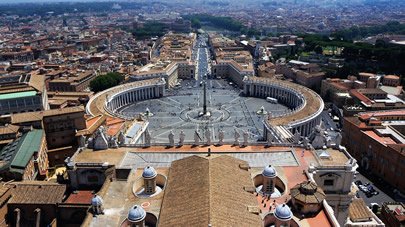
The headquarters of the Roman Catholic Church and the center of the Catholic world, Vatican City (Citta del Vaticano in Italian) is a fully independent nation-state located within the city of Rome that is ruled by the pope. It was founded in 1929 to allow the pope to exercise his universal authority over Catholics throughout the world.
It is the world's smallest independent state (but often said to be the worlds smallest country) covering a territory of just 0.44km (approximately 0.2 sq miles or 100 acres) and has a population of between 800-1,000 people though only half this number actually live inside Vatican City. The residents are mostly priests, nuns, and guards but there are also hundreds of workers who perform secretarial, domestic, service, and trade occupations.
Vatican City contains the home of the pope, Vatican Palace, otherwise known as the Apostolic Palace, St Peter's Basilica, the Sistine Chapel, the Vatican Gardens and the Vatican museums. It has its own flag, own national anthem, own stamps and coins, own TV and radio station, own newspaper, and own license plates, but not its own language! Italian is the unofficial day-to-day language used in Vatican City.
THE VATNICAN MUSEUM CONTAINS THE GREATEST ART COLLECTION IN THE WORLD.
Covering 43,000 square meters and containing 70,000 works, of which 20,000 are on public display the Vatican Museum consist of more than 50 individual museums (rooms, galleries, and chapels) within one complex. The Vatican museums include:
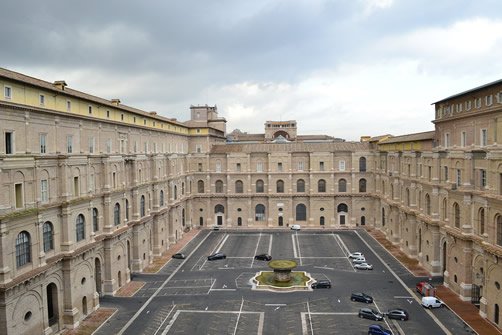
This room contains 9 ceremonial Berlin carriages, 2 historic travelling Berlin coaches plus a fleet of cars used by various popes, Cardinals, and princes over the centuries. It includes the Grand Gala Berlin which was one of five carriages built for the Grand Duke of Tuscany, Ferdinand III, the Fiat Campagnola that was linked to the assassination attempt on pope John Paul II in 1981, and 3 Popemobiles.
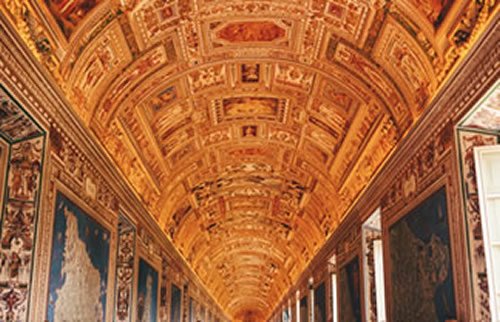
40 maps are frescoes on the walls of this gallery which show the Italian regions and papal properties at the time of pope Gregory XIII who ruled from 1572-1585.
A collection of approximately 1,000 Roman statues, busts, and portraits of Roman Emperors and Gods plus friezes and sarcophagi reliefs are in this museum. The collection includes a statue of Emperor Augustus, a Roman copy of the statue of Nile, 2 gilded bronze peacocks that are thought to have come from Hadrian's Mausoleum, and a funerary monument of a miller dating from the 1st century.
Containing sacred inscriptions on stone (including a fragment of Roman calendar), inscriptions commemorating emperors and fragments of inscriptions on slabs showing the organisation of the Romany army, visitors can also see some fragments from everyday life in Ancient Rome. There is also a separate Jewish Lapidarium that contains nearly all of the inscriptions recovered during the excavation of the Jewish catacomb of Monteverde and a separate Christian Lapidarium.
This museum features original Ancient Greek sculptures with a selection of funerary steles, votive reliefs, and sculptural fragments as well as copies and reconstructions of Greek sculptures, statues, and portraits that were created and displayed during the Roman age. Key pieces include original fragments of marble from the Parthenon in Athens, reliefs from the Palazzo della Cancelleria, and restored mosaics from the Bath of Caracalla.
With both permanent and temporary exhibition, this museum's focus is on displaying the cultural, artistic and spiritual heritage of civilisations from every corner of the globe. Visitors can admire exotic curiosities from pre-historic times, works from pre-Colombian times, items from the indigenous peoples of America and Australia, works from Africa and Asia, and items from Islamic civilisations.
Originally focusing on the display of art and tools originating from catacombs (which can still be seen), this museum, housed in the stunning former apartment of the Master of the Sacred Palaces, now also houses the collections of applied arts. Visitors can view silverware, ivories, enamels, chalices, crosses and other religious objects from every era.
Displayed in 9 rooms, visitors can view Italian and international paintings and sculptures from the 19th century to the 20th century. It includes works of art by Vincent Van Gogh, Henri Matisse, Francis Bacon, Marc Chagall, Carlo Carra, Giorgio de Chirico, Giacomo Manzu, Lucio Fontana, and Alberto Burri amongst others.
Otherwise known as the Pio Cristiano Museum, this museum contains artefacts from the Christian communities of the first centuries. Fragments of sarcophagi featuring Christian imagery from the 3rd to 5th centuries as well as mosaics, statues and an early Medieval frescoe can be seen.
7 rooms contain Etruscan antiques including figures, sculptures, urns, bronzes, jewelry, and sarcophaguses. The Ancient Etruscan civilization was powerful and wealthy, occupying a region North of Rome between approximately 700 BC until the late 4th century when it was finally absorbed into the Roman Republic.
View the lavish decoration in 6 rooms that formed pope Alexander VI aka Rodrigo Borgia residence during his time as pope. These rooms are:
Otherwise known as Raphael's Rooms, these rooms were inhabited by Pope Julious II who gave Raphael permission to remove all previous artwork (including that of Perugino who was Raphael's master) on the walls and ceilings and free reign to paint something new. The following 4 rooms were painted over the span of 16 years:
The first room to be painted by Raphael was the papal library, work beginning in 1508. This room represents the 3 Neoplatonic categories of Truth, Goodness, and Beauty.
This room has a reoccurring theme of God assisting mankind, it glorifies the Church's spiritual and temporal power.
This room shows famous historical events and is named after the main fresco in the room which represents a fire extinguishing miracle that was performed by pope Leo IV in 847.
The last room to be completed, in 1524, this room was mostly painted by Raphael's pupils after Raphael's sudden death in 1520.
Containing 18 rooms, this art gallery (otherwise known as the Pinacoteca Vaticana) contains many valuable paintings which cover the 12th-16th centuries and are arranged in chronological order for easy viewing. The collection was started by pope Pius VI and expanded over the centuries by the popes that followed. Some of the most notable and famous paintings housed here include:
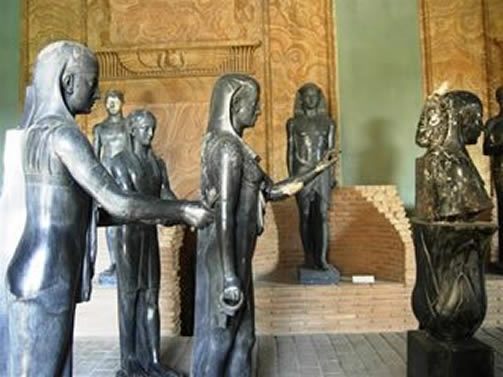
9 rooms contain the Vatican's collection of Ancient Egyptian antiquities curated by Egyptologist Barnabite Father Luigi Ungarelli as well as artefacts from the Ancient Near East. Painted mummy cases, sarcophagi and other funerary accoutrements, pharaoh and queen statues, and more can be admired by visitors.
This museum contains important classical Greek and Roman sculptures that began with the collection of pope Julius II and greatly expanded in the 18th century due to excavation works carried out in Rome and Lazio.
Also known as "The Medals Room", this section, with antique furnishings, contains artefacts from the 18th-20th century found in the Papal States as well as the Middle East and South America. Collections include ancient Colombian artefacts, middle-eastern seals, 18th century statuette's, pre-Roman materials, and other "odds and ends" that don't fit into the other museum collections!
It is not clear where the word Vatican comes from, but there are a few theories...
THE VATICAN HAS ACCUMULATED 2,000 YEARS OF RICHES
MAKING IT TRULY PRICELESS!
The Roman Catholic institution is the richest on earth but the Vatican has never publicly disclosed just how much it's worth. It gets a little complicated because the Vatican is composed of 2 entities, the Vatican City-State which maintains the Vatican museums, pays the security force which includes the Swiss guard, and provides municipal services for the sovereign nation. Meanwhile, the Holy See employs thousands of workers from labourer's to those working at Radio Vatican right up to Cardinals but it maintains that even the top members work for a minimal fee.
It is known that the Vatican has big investments in banking, insurance, construction, steel, chemicals, real estate, and technology, but unlike regular stockholders, the Vatican does not pay tax on that income. The dividends from these investments fund charity work and maintain the Vatican.
In 1965 bankers estimated the Vatican's wealth to be between $10-$15 billion but in 1987, when Forbes magazine made investigations, they claimed that the Vatican was spending almost twice as much annually as it bought in and was nearly broke. On the Fortune.com site you can read that, in 1987 "The Holy See, the administrative center of the Church and the spiritual capital of its members, took in $57.3 million from sources as diverse as fees for ceremonies; income from publications, newspaper ads, and the sale of videocassettes; and surprisingly modest investment earnings of $18 million."
In 2004 Nicole Winfield estimated that the Holy See's real estate (excluding the Sistine Chapel and St. Peter's Basilica) was valued at $900 million.
In 2014 the Vatican City State had a surplus of €63.5 million, almost double the amount of 2013, as reported in MoneyCNN whilst the Holy See reported a deficit of €25.6 million, its biggest expense being the wages of almost 3,000 employees which is said to have totalled €126.6 million.
But this wealth, or lack thereof, doesn't account for the collection of 2,000 years worth of art and artefacts that are sitting in the Vatican museums. It might be impossible to put a price on it but we do know that the church owns the largest and most priceless collection of art in the world.
Yes and no. Visitors can access St Peter's Basilica and St Peter's Square free of charge but there is a fee for St Peter's Dome, The Vatican museums and The Sistine Chapel.
Access to St Peter's Dome:
By Stairs: €6.00
By Lift: €8.00
Vatican museums & Sistine Chapel:
Standard Adult Ticket: €17.00
Reduced Ticket for Children*, Students, & Priests: €8.00
Skip the line tickets cost €4.00 extra
*Children Under 6 Years Old Enter Free of Charge
St Peter's Square / St Peter's Basilica and The Sistine Chapel and Vatican museums have different entry points. The Vatican museums which includes entry to the Sistine Chapel is accessed from the North side on viale Vaticano. St Peter's Square and the Basilica are on the Southeastern side and are accessed from via della Conciliazione.
If walking from Piazza Venezia to St Peter's Square it will take approximately 30 minutes but you can also make use of Rome's public transport.
By Public Bus:
By Metro:
Both metro stations are a 10 minute walk from Vatican City. You can get off at:
By Tour Bus:
Taking you around all of Rome's top attractions including dropping you off by Vatican City, you can compare the hop-on-hop-off tour buses here to see which is right for you.
PLEASE NOTE: There is no public access from the West of St. Peter's Square.
No, despite being an independent state you do not need to show your passport to go to Vatican City. However, when collecting pre-booked tickets for the Vatican ID is sometimes required in which case a valid passport, or a driving license etc. can be used.
See the Vatican Calendar for exact dates when the Vatican is open as some closures do occur. Generally the opening hours are as follows:
Vatican museums:
Monday-Saturday: 9.00am-6.00pm
Sunday: Closed unless last Sunday of the month
Last Sunday of the month: 9.00am-2.00pm* (FREE ENTRY)
Vatican Museum ticket offices close 2 hours before, so last entry is at 4.00pm Monday-Saturday and 12:30pm last Sunday of the month.
Visitors are asked to leave the halls 30 minutes before closure times.
*Excluding Easter Sunday, St Peter & St Paul's Day, Christmas Day and Boxing Day should any of these fall on the last Sunday of the month.
St Peter's Basilica:
Monday-Sunday April-September: 7am-7pm
Monday-Sunday October-March: 7am-6pm
The Sistine Chapel has been the pope's private chapel since the time it was built and is famous for its stunningly beautiful and intricate interior featuring frescoes by many Florentine Renaissance masters, most notably, the ceiling painted by Michelangelo. It's the site of principle papal ceremonies including the election of a new pope by the Cardinals.
Built between 1473-1481 for pope Sixtus IV (from whom it gets its name, Sixtus being Sisto in Italian), the Sistine Chapel (Cappella Sistina in Italian) held its first Mass on August 15th 1483. Though famous for Michelangelo's frescoes on the ceiling, the chapel was first decorated by Botticelli who painted the two side walls of the chapel between 1481-1483, 1 wall frescoed with the story of Moses, the other with the story of Christ. Above these, smaller frescoes depicting various popes were placed between the windows. The ceiling was originally decorated with a depiction of the night sky with a few gold stars by Piero Matteo d'Amelia, an Umbrian artist.
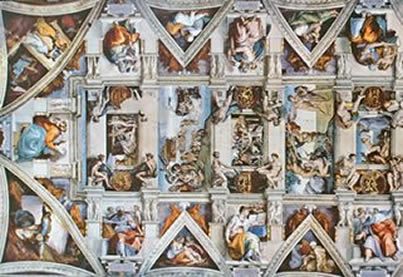
Michelangelo's frescoes were not commissioned until 1508 when pope Julius II was in power. Julius II wanted to put his own stamp on the Sistine Chapel whilst also covering up some cracks that has appeared in the sky fresco during construction work and envisaged images of the 12 Apostles. But Michelangelo dismissed the Apostles decoration as a "bad idea" and was given free-reign (most likely with guidance from the papal court theologians) to create a masterpiece. The ceiling depicts stories from the Old Testament Book of Genesis - From the Creation (images showing God creating the sun, moon, Earth, darkness, and light) through to the story of Noah. Michelangelo also created a fresco on the west wall behind the altar showing The Last Judgement, this was painted between 1534-1541 for Pope Paul III.
The ceiling that we see today, the frescoes painted by Michelangelo, were started in July 1508 and unveiled sometime in October 1512 so it took just over 4 years to complete. The first half of the ceiling, from the entrance wall to the Creation of Eve was finished in August 1510. There's evidence that the pope celebrated Mass in the newly decorated chapel on 1st November 1512.
The Sistine Chapel is located within The Vatican complex, slightly North-West of St Peter's Square but can only be accessed when visiting the Vatican museums - It's almost at the end of the museums tour. It is possible to go inside the Sistine Chapel to admire the stunning fresco's but tourists cannot attend Mass unless they are a member of the clergy or have received an invitation from the pope himself or from a member of the chapel's choir.
Entrance to the Sistine Chapel is covered by the Vatican museums ticket. You cannot purchase a separate Sistine Chapel only ticket.
Vatican museums & Sistine Chapel:
Skip the line tickets cost €4.00 extra
Technically, No. Visitors are told not to take photos or videos inside the Sistine Chapel and security guards located within the chapel remind visitors of this by shouting "No Photos!" when visitors pull out their cameras and phones. The rule doesn't seem to be enforced though with rule breakers ignoring the guards and taking discreet, or not so discreet, photos inside the chapel.
St Peter's Basilica IS THE GREATEST BUILDING OF THE ITALIAN RENAISSANCE PERIOD
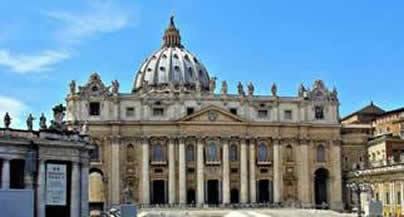
St Peter's Basilica aka the Papal Basilica of St. Peter is the papal enclave and the pope's principle church in terms of use and has been deemed a UNESCO World Heritage Site. The largest church in the world, covering 2.3 hectares (5.7 acres), it is the most dominant building in Vatican City and is regarded as one of the holiest Catholic shrines, one of the greatest churches in Christendom, and the burial site of Saint Peter who was head of Jesus's 12 Apostles and who became the Bishop of Rome I.e the very first Pope. It is a famous place for pilgrimages, St Peter's tomb thought to be directly below the high altar of the Basilica.
Since Early Christian times St Peter's Basilica has been the location where popes are interred but it is not a Cathedral, as many people mistakenly assume, as it is not the seat of a bishop. Construction of the current St Peter's Basilica began in 1506 (replacing the Old St. Peter's Basilica from the 4th century) and was finally completed in 1626. It took so many years to complete due to the death of Pope Julius as well as the death of several architects mid-way through the construction, one of whom was Raphael. Michaelangelo, who was then in his 70's, was eventually hired to bring the construction of St Peter's Basilica to its final stages of completion but it wasn't a job he wanted, Pope Paul forced it upon him!
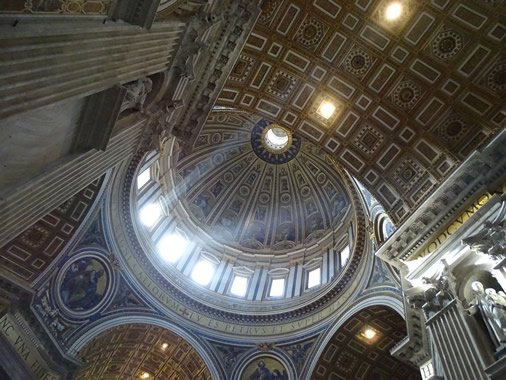
The magnificent Dome of St. Peter's is a landmark of Rome as well as Vatican City, it rising more than 136 metres (448 ft) from the floor to the top of the cross and measuring 41 metres (136 feet) in diameter making it the tallest dome in the world but not the widest.
Yes, entrance to St Peter's Basilica is free of charge but a visit to the dome costs €6 or €8 depending on if you take the stairs or the lift to the top.
You can purchase tickets and tours online before you go, or from the ticket offices when you arrive.
Beware of anyone offering to sell you tickets to the Sistine Chapel Only - Individual tickets do not exist, the Sistine Chapel is visited with the Vatican museums entrance ticket.
Arrive early or late to avoid the worst of the crowds and pre-book fast-track entrance tickets. You should also try to avoid the peak summer season (June-August) if possible.
If taking a DIY tour (without a tour guide) you could arrive at St Peter's Basilica for opening at 7am, spend an hour taking in the architecture before going up to the dome at 8am when it opens and then move onto the Vatican museums ready for opening at 9am, taking into account the 20 minute walk between St Peter's Square and the Vatican museums entrance.
The Vatican museums (including the Sistine Chapel) are FREE OF CHARGE on:
There are no skip-the-line tickets and no tours on free entry days.
Some exclusions apply - See Vatican Calendar for more details.
Disabled visitors with a certified invalidity of more than 74% receive free entry. Disabled persons who are not self-sufficient can bring a companion free of charge too.
Most definitely, and it's only €4.00 extra so even budget travellers can afford it. Although some queuing should still be expected with a fast-track ticket, you will skip the 2 hour + line just to reach the ticket office and security!
With a choice of 2 departure times (8.30 or 12.30) your friendly and knowledgeable tour guide will show you around the Vatican museums, the Sistine Chapel, and St Peter's Basilica on a 3 hour guided tour. Enjoy fast-track entry plus quick access between the Museums and St Peter's Basilica which is reserved for tour groups only. You'll get to see The Raphael Rooms, The Sistine Chapel, St Peter's Basilica, The Greek Cross Room, the Round Room, the Gallery of Maps, the Octagonal Courtyard and more with the opportunity to ask questions throughout the tour.
Get fast-track entry into the Vatican early in the morning before it opens to general visitors ensuring your experience is not ruined by the crowds. Upon arrival at 7.15am or 8.15am you will get a complimentary Italian style buffet breakfast followed by an extensive tour of the Vatican museums. This VIP experience includes access to exhibitions that are normally closed to the general public. There's also fast-track entry to St Peter's Basilica and the Sistine Chapel which you can explore at your own pace afterwards.
Alternatively, if you want to explore The Vatican at your own pace, independently, you can buy fast-track tickets without the restrictions of a guided tour:
Get fast-track entry into the Vatican museums which includes the Sistine Chapel. Explore at your own pace, no need to hurry after a tour guide or wait for other people in the group as this is for entrance tickets only.
Enjoy priority entrance into St Peter's Basilica with or without an audio guide. There are 4 timed entry sessions to choose from; 8.45 - 10.00, 10.00 - 13.00, 13.00 - 15.00, or 15.00 -17.00 and once inside, you can spend as much or as little time as you want. This is good for travellers who have limited time and dislike group tours.
There are a variety of city cards / passes that include The Vatican as well as other top attractions in Rome that you can purchase to help you save money when sightseeing. Which one you opt for, and if it will save you money, depends on what exactly you want to do and for how many days you'll be in Rome. Passes which include fast-track entry to The Vatican museums are:
Tripindicator is doing unbiased Comparison of Omnia Pass vs Roma Pass vs Rome City Pass
Yes, no matter whether you buy the 2, 3, or 6 day Roma Pass you can get free entry fast-track entry into the Vatican museums which includes entry to the Sistine Chapel. You also get free public transport so will be able to get to the Vatican quickly and easily.
If you're still undecided on the Roma Pass, see below link
Unbiased Comparison of Roma Pass or Omnia Pass